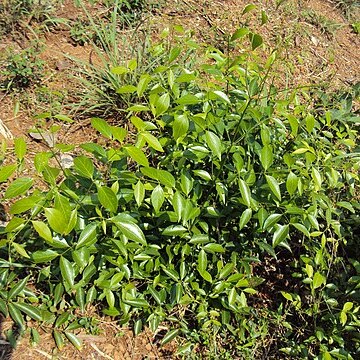Liana, sometimes a small shrub or tree. Stipule triangular, c. 0.5 mm long, 3-lobed, laciniate or fimbriate, sometimes just a series of short filaments along the branchlet below the petiole. Leaves chartaceous, ovate, broad-ovate, elliptic to elliptic-oblong, rarely obovate, or broad-elliptic, 3.5-13 by 2-6.5 cm; base cuneate; apex acuminate, short--apiculate; margin crenulate; nerves 5-8 pairs; petiole 5-8 mm. Inflorescences cymose, 2-6 cm long, sometimes very short, usually with supplementary branchlets in the dichotomies. Peduncle very short, sometimes up to 3.5 cm. Bracts triangular, c. ⅔ mm long, laciniate, sometimes fimbriate at the base. Pedicels 1/3-1 mm. Flowers light yellow or greenish yellow, small. Calyx thin, papillose on both surfaces, almost divided to the base, lobes triangular, 0.5-2/3 mm long, slightly erose. Petals ± oblong, 1-1.5 by 0.25-0.5 mm, papillose on both surfaces. Disk with the free part opposite the stamens slightly thicker. Stamens 0.5-1 mm. Free part of pistil flask-like, c. 0.5 mm long. Ovules 2 in each cell, inserted at the base. Follicles elliptic-or obovate-oblong, 3-5.5 by 1.25-1.5 cm; pericarp leathery, valves c. 1/3 mm thick, the sutural margins slightly spreading after dehiscence. Seeds (incl. wing) 2.75-3½ by 1 cm, seed proper broad-elliptic, or elliptic, 1-1 1/3 by 0.5-⅔ cm.
More
A climbing shrub. It grows 1-5 m tall or 12 m long. The small branches are green and slightly angular when young. The leaves are 4-12 cm long by 3-7 cm wide. The flowers are white to yellow. The seeds have wings.
Liane, scandent shrub or small tree, up to 12 m high. Leaves oblong, 40-150 x 20-100 mm, greyish green, glabrous. Inflorescence lax to dense. Flowers small. Mericarps pale green. Flowers cream.
In rain-and monsoon-forests, on ridges, in secondary forests, sometimes found on limestone, from the lowland up to 650 m.
Uses. According to HEYNE ( HEYNE Nutt. Pl. 1927 985 ) the sap of the stem is drunk for treating fever. The leaves, slightly scorched and seasoned with sambal, are given to eat to women in childbed, and compounded with adas-pulasari (Alyxia sp.) are used for poultice in treating rheumatism.

